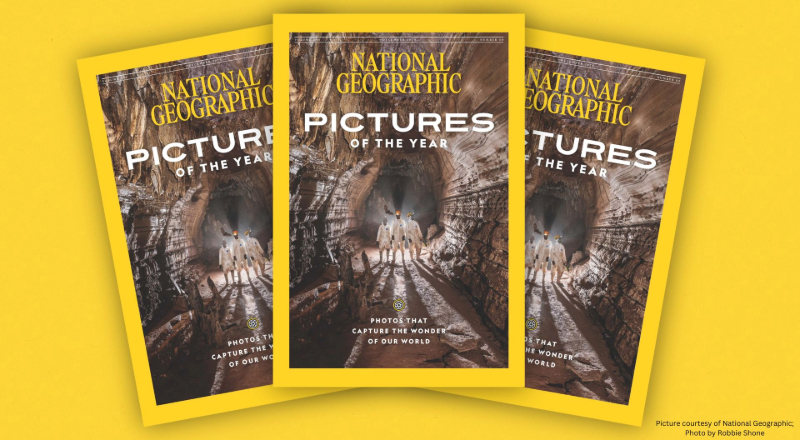Teesside University-led team makes National Geographic's 'Pictures of the Year' cover
A research project led by a Teesside University academic is featuring on the front cover of a National Geographic magazine as it celebrates the best photographs of the last 12 months.

The groundbreaking research of Dr Lisa Baldini and her team is captured on the front of the December 'Pictures of the Year’ edition.
The image, by world-renowned cave photographer and project partner Robbie Shone, graces the magazine’s cover and a two-page spread.
Dr Baldini’s research was funded in 2022 by a National Geographic Society Explorer grant, and the image was taken during a June 2024 caving expedition to Gabon.
In the photograph, Dr Baldini’s colleagues are illuminated by a dramatic backlight as they explore a Grotte de Bongolo cave passage. In a moment of perfect timing, a large Egyptian fruit bat is silhouetted in flight in front of them.
Dr Baldini said: 'This is an iconic image featuring our Nigerian project partners, Professor Ndukauba Egesi and Dr Mike Agbebia, alongside my Teesside University PhD student, Fatai Ilesanmi.
'It perfectly captures the spirit of our work in West and Central Africa.'
Since 2022, Dr Baldini and her local collaborators – Professor Egesi at the University of Port Harcourt (Nigeria), Dr Florence Njinto Kwankam at the University of Bamenda (Cameroon), and Dr Alexis Ndongo at the University of Masuku (Gabon) – have led the wider research team on expeditions across this understudied region. Their work focuses on identifying stalagmites that hold critical clues about ancient rainfall patterns.
The primary goal of this work is to unravel the factors driving shifts in Africa’s tropical rainfall belt over millennia, both before and after the onset of human-induced climate change.
Gabonese palaeoclimatologist and project collaborator, Professor Makaya M’voubou from the University of Masuku, has previously used lake sediments to reconstruct Gabon’s climate history. 'Our records show much drier conditions around 2,500 years ago, followed by a shift to wetter conditions over the past millennium,' he said. 'The new stalagmite data will provide higher-resolution, more precisely dated insights into the timing and causes of these climate transitions.'
During the 2023 and 2024 caving expeditions to Gabon, the team successfully recovered vital stalagmite samples that will soon reveal the region's detailed paleoclimate history. 'These samples are now undergoing analysis at Durham University and Northumbria University in the UK, as well as US and Chinese institutions,' Dr Baldini said.
This is an iconic image... It perfectly captures the spirit of our work in West and Central Africa.
Durham University project partner Professor James Baldini has researched the tropical rainfall belt in Belize since 2010.
He said: 'Our research in both Africa and Belize shows just how sensitive these rainfall systems are to human activity.
'This data will be crucial for refining climate models and helping African nations make informed decisions to build resilience against future climate change.'
In addition to the project’s scientific goals, Dr Lisa Baldini is focused on raising awareness about the importance of caves – not only as rich ecosystems that house unique species like the Egyptian fruit bat, but also as key sources of data for climate research.
The cement industry is actively mining karst landscapes across Africa.
'We’re hoping to raise awareness that African caves are not only rich in biodiversity but also essential for understanding the continent’s sensitivity to climate change – and should be protected,' she said. 'Southern Gabon is home to many caves like this one which lie beneath some of the world’s most biodiverse and pristine rainforests.'
In June 2024, Dr Baldini and her Masuku University colleagues, Professor M'voubou, Dr Ndongo, and Dr Stevy Retonda Kondja, presented their research to Gabonese government officials and local stakeholders in Lebamba, Ngounié Province. A key outcome of the meeting was a shared recognition of the region’s ecotourism potential, which could provide essential funding to support conservation efforts and help reduce pressures on Gabon’s rich natural resources.
Dr Baldini and her team’s work promises to contribute vital data to global climate science, helping to predict and mitigate the impacts of climate change in some of the world’s most vulnerable regions.
You can follow the Western African Palaeoclimate Project and meet all of its team members on Facebook and X.
 Teesside University-led team makes National Geographic's
...
Teesside University-led team makes National Geographic's
...